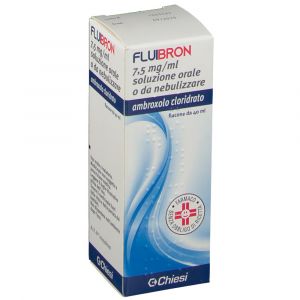Ship in Europe, Find out rates!
Language

Fluibron Oral Solution Or To Be Nebulized Bottle 40ml 0.75%
CHIESI FARMACEUTICI
SKU
024596049
Special Price
€13.41
Regular Price
€14.85
Save... €1.44
-10%
Recent lowest price:
€13.78
In stock
NAME
FLUIBRON
PHARMACOTHERAPEUTIC CATEGORY
Expectorants, excluding associations with cough suppressants; mucolytics.
ACTIVE PRINCIPLES
Children 15 mg granules for oral suspension: ambroxol hydrochloride 15mg. 7.5 mg / ml oral or nebulised solution: 100 ml of solution contain 750 mg ambroxol hydrochloride.
EXCIPIENTS
Oral solution or to be nebulized: sodium chloride, methyl p-hydroxybenzoate, propyl p-hydroxybenzoate, purified water. Granules for oral suspension for children: sorbitol, mannitol, orange flavor, citric acid monohydrate, glycine, gum arabic, sodium saccharin, colloidal anhydrous silica, orange yellow S (E 110).
INDICATIONS
Treatment of secretion disorders in acute and chronic bronchopulmonary affections.
CONTRAINDICATIONS / SECONDARY EFFECT
Hypersensitivity 'to the active substance or to any of the excipients. Severe hepatic and / or renal disorders. Pediatric population: the medicine is contraindicated in children younger than 2 years.
DOSAGE
Sachets. Children from 5 years of age: 1 sachet Children 2-3 times a day depending on the age, dissolved in water. Oral solution or to be sprayed. By inhalation. Adults and children over five years of age: 2-3 ml, 1-2 times a day. Children aged two to five years: 2 ml, 1-2 times a day. The solution can be administered using normal aerosol therapy devices. It can also be diluted in distilled water in the ratio 1: 1. Orally. Adults: 2-4 ml (15-30 mg) 3 times a day. Children older than five years: 1-2 ml (7.5-15 mg) 2-3 times a day. Children aged 2 to 5 years: 1 / 2-1 ml (3.75-7.5 mg) 2-3 times a day. 1 ml = 7.5 mg. Dilute the drops in a little water, tea, milk or fruit juice.
STORAGE
This medicinal product does not require any special storage conditions.
WARNINGS
Mucolytics can induce bronchial obstruction in children less than 2 years of age. In fact, the drainage capacity of the bronchial mucus is limited in this age group, due to the physiological characteristics of the respiratory tract. They should therefore not be used in children younger 'less than 2 years. Administer with caution in patients with peptic ulcer. Since irritation cough may arise in the too deep inhalation of the aerosols, one must try to inhale and exhale normally during inhalation. In particularly sensitive patients, a pre-heating of the inhaled to body temperature can be recommended. For patients suffering from bronchial asthma it is advisable to resort to a bronchial spasmolytic before inhalation. Extremely rare cases of severe skin lesions such as Stevens-Johnson syndrome and toxic epidermal necrolysis (TEN) have been reported in temporary association with administration of expectorants such as ambroxol hydrochloride. Most of these cases can be explained by the severity of the patient's underlying disease and / or by concomitant therapy. In addition, during the initial phase of Stevens-Johnson syndrome or TEN, patients may experience nonspecific flu-like prodromes such as fever, body aches, rhinitis, cough and sore throat. Because of these misleading nonspecific flu-like prodromes, symptomatic treatment with cough and cold medicines is possible. Therefore, if new lesions of the skin or mucous membranes occur, it is necessary to consult a doctor immediately and to stop the treatment with ambroxol hydrochloride as a precaution. In the presence of mild or moderate renal insufficiency, the medicinal product should only be used after consultation with your doctor.As with any medicinal product with hepatic metabolism followed by renal elimination, accumulation of the metabolites of ambroxol generated in the liver may occur in the case of severe renal insufficiency. .
INTERACTIONS
Following the administration of ambroxol the concentrations of antibiotics (amoxicillin, cefuroxime, erythromycin) in bronchopulmonary secretions and saliva are increased. No interactions with other medicinal products have been observed.
SIDE EFFECTS
At the recommended doses the medicine is normally well tolerated. Frequencies side effects: very common> = 1/10, common> = 1/100 and <1/10, uncommon> = 1 / 1,000 and <1/100, rare> = 1 / 10,000 and <1 / 1,000, very rare <1 / 10,000, not known. Disorders of the immune system. Not known: hypersensitivity reactions' such as edema, angioedema, urticaria, pruritus, skin rash, erythema. Nervous system disorders. Common: dysgeusia (for example, altered sense of taste); rare: headache. Respiratory, thoracic and mediastinal disorders. Common: hypoesthesia of the oral cavity and pharynx; not known: bronchial obstruction. Gastrointestinal pathology. Common: nausea; uncommon: vomiting, diarrhea, dyspepsia and abdominal pain, dry mouth; not known: dry throat Report any suspected adverse reactions via the national reporting system.
PREGNANCY AND BREASTFEEDING
Ambroxol hydrochloride crosses the placental barrier. Animal studies have shown no direct or indirect harmful effects on pregnancy, embryonal / fetal development, parturition or postnatal development. Clinical studies and extensive clinical experience after the 28th week of pregnancy have shown no evidence of harmful effects on the fetus. However, it is recommended to observe the usual precautions regarding the use of medicines during pregnancy. Particularly during the first trimester, use is not recommended. Ambroxol hydrochloride is secreted in breast milk. Although undesirable effects on infants are not expected, its use is not recommended in nursing mothers.
FLUIBRON
PHARMACOTHERAPEUTIC CATEGORY
Expectorants, excluding associations with cough suppressants; mucolytics.
ACTIVE PRINCIPLES
Children 15 mg granules for oral suspension: ambroxol hydrochloride 15mg. 7.5 mg / ml oral or nebulised solution: 100 ml of solution contain 750 mg ambroxol hydrochloride.
EXCIPIENTS
Oral solution or to be nebulized: sodium chloride, methyl p-hydroxybenzoate, propyl p-hydroxybenzoate, purified water. Granules for oral suspension for children: sorbitol, mannitol, orange flavor, citric acid monohydrate, glycine, gum arabic, sodium saccharin, colloidal anhydrous silica, orange yellow S (E 110).
INDICATIONS
Treatment of secretion disorders in acute and chronic bronchopulmonary affections.
CONTRAINDICATIONS / SECONDARY EFFECT
Hypersensitivity 'to the active substance or to any of the excipients. Severe hepatic and / or renal disorders. Pediatric population: the medicine is contraindicated in children younger than 2 years.
DOSAGE
Sachets. Children from 5 years of age: 1 sachet Children 2-3 times a day depending on the age, dissolved in water. Oral solution or to be sprayed. By inhalation. Adults and children over five years of age: 2-3 ml, 1-2 times a day. Children aged two to five years: 2 ml, 1-2 times a day. The solution can be administered using normal aerosol therapy devices. It can also be diluted in distilled water in the ratio 1: 1. Orally. Adults: 2-4 ml (15-30 mg) 3 times a day. Children older than five years: 1-2 ml (7.5-15 mg) 2-3 times a day. Children aged 2 to 5 years: 1 / 2-1 ml (3.75-7.5 mg) 2-3 times a day. 1 ml = 7.5 mg. Dilute the drops in a little water, tea, milk or fruit juice.
STORAGE
This medicinal product does not require any special storage conditions.
WARNINGS
Mucolytics can induce bronchial obstruction in children less than 2 years of age. In fact, the drainage capacity of the bronchial mucus is limited in this age group, due to the physiological characteristics of the respiratory tract. They should therefore not be used in children younger 'less than 2 years. Administer with caution in patients with peptic ulcer. Since irritation cough may arise in the too deep inhalation of the aerosols, one must try to inhale and exhale normally during inhalation. In particularly sensitive patients, a pre-heating of the inhaled to body temperature can be recommended. For patients suffering from bronchial asthma it is advisable to resort to a bronchial spasmolytic before inhalation. Extremely rare cases of severe skin lesions such as Stevens-Johnson syndrome and toxic epidermal necrolysis (TEN) have been reported in temporary association with administration of expectorants such as ambroxol hydrochloride. Most of these cases can be explained by the severity of the patient's underlying disease and / or by concomitant therapy. In addition, during the initial phase of Stevens-Johnson syndrome or TEN, patients may experience nonspecific flu-like prodromes such as fever, body aches, rhinitis, cough and sore throat. Because of these misleading nonspecific flu-like prodromes, symptomatic treatment with cough and cold medicines is possible. Therefore, if new lesions of the skin or mucous membranes occur, it is necessary to consult a doctor immediately and to stop the treatment with ambroxol hydrochloride as a precaution. In the presence of mild or moderate renal insufficiency, the medicinal product should only be used after consultation with your doctor.As with any medicinal product with hepatic metabolism followed by renal elimination, accumulation of the metabolites of ambroxol generated in the liver may occur in the case of severe renal insufficiency. .
INTERACTIONS
Following the administration of ambroxol the concentrations of antibiotics (amoxicillin, cefuroxime, erythromycin) in bronchopulmonary secretions and saliva are increased. No interactions with other medicinal products have been observed.
SIDE EFFECTS
At the recommended doses the medicine is normally well tolerated. Frequencies side effects: very common> = 1/10, common> = 1/100 and <1/10, uncommon> = 1 / 1,000 and <1/100, rare> = 1 / 10,000 and <1 / 1,000, very rare <1 / 10,000, not known. Disorders of the immune system. Not known: hypersensitivity reactions' such as edema, angioedema, urticaria, pruritus, skin rash, erythema. Nervous system disorders. Common: dysgeusia (for example, altered sense of taste); rare: headache. Respiratory, thoracic and mediastinal disorders. Common: hypoesthesia of the oral cavity and pharynx; not known: bronchial obstruction. Gastrointestinal pathology. Common: nausea; uncommon: vomiting, diarrhea, dyspepsia and abdominal pain, dry mouth; not known: dry throat Report any suspected adverse reactions via the national reporting system.
PREGNANCY AND BREASTFEEDING
Ambroxol hydrochloride crosses the placental barrier. Animal studies have shown no direct or indirect harmful effects on pregnancy, embryonal / fetal development, parturition or postnatal development. Clinical studies and extensive clinical experience after the 28th week of pregnancy have shown no evidence of harmful effects on the fetus. However, it is recommended to observe the usual precautions regarding the use of medicines during pregnancy. Particularly during the first trimester, use is not recommended. Ambroxol hydrochloride is secreted in breast milk. Although undesirable effects on infants are not expected, its use is not recommended in nursing mothers.
| Destination | Cost | Detail |
|---|---|---|
| Italy | €5,90* | 24/72H |
| Austria, France, Germany, Slovenia | € 13* | 3 days |
| Belgium, Luxembourg, Portugal, Netherlands, Spain | € 14* | 4 days |
| Bulgary, Cechia, Hungary, Poland, Romania, Slovakia | € 19* | 5 days |
| Denmark, Estonia, Finland, Ireland, Lithuania, Latvia ,Sweden | € 22* | 5 days |
| United Kingdom, Switzerland, Greece | € 30* | 7 days |
| Canada, USA | € 40 | 7 Days |
European shipments with express courier: FedEx, MBE, DHL
*For the shipment outside band B ther's an extra cost of 22€ *For the shipment outside band C ther's an extra cost of 30€ Delivery Times exclude Saturday and Holidays
For Islands and Areas of difficult Accessibility the shipments are made in 72 hours and the cost will be increased by 15€
The images of the products shown on our site are purely indicative and may differ in shape, color, text and packaging shown on them. Given the difficulty of updating all the products on our site in real time or any errors, XFarma.it, all products will be identified through SKU MINSAN (code of the Ministry of Health).
The transport of medicines sold online is carried out in compliance with the guidelines on good distribution practice according to Article 112-quater, paragraph 10. (Italy)
